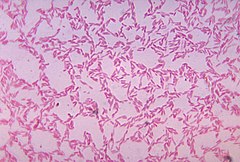Bacteroides: Difference between revisions
m Reverted edits by 158.123.160.40 to last revision by Alansohn (HG) |
Tag: section blanking |
||
| Line 37: | Line 37: | ||
"[[Bacteroides melaninogenicus]]" has recently been reclassified and split into ''[[Prevotella melaninogenica]]'' and ''[[Prevotella intermedia]]''.<ref name="urlBacteroides Infection: Overview - eMedicine">{{cite web |url=http://emedicine.medscape.com/article/233339-overview |title=Bacteroides Infection: Overview - eMedicine |format= |work= |accessdate=2008-12-11}}</ref> |
"[[Bacteroides melaninogenicus]]" has recently been reclassified and split into ''[[Prevotella melaninogenica]]'' and ''[[Prevotella intermedia]]''.<ref name="urlBacteroides Infection: Overview - eMedicine">{{cite web |url=http://emedicine.medscape.com/article/233339-overview |title=Bacteroides Infection: Overview - eMedicine |format= |work= |accessdate=2008-12-11}}</ref> |
||
==Pathogenesis== |
|||
''Bacteroides'' species also benefit their host by excluding potential pathogens from colonizing the gut. Some species (''B. fragilis'', for example) are [[Opportunistic infections|opportunistic human pathogens]], causing infections of the peritoneal cavity, gastrointestinal surgery, and [[appendicitis]] via abscess formation, inhibiting [[phagocytosis]], and inactivating [[β-lactam antibiotics|beta-lactam antibiotics]].<ref name=Sherris>{{cite book | author = Ryan KJ, Ray CG (editors) | title = Sherris Medical Microbiology | edition = 4th | publisher = McGraw Hill | year = 2004 | isbn = 0-8385-8529-9 }}</ref> Although ''Bacteroides'' species are anaerobic, they are [[aerotolerant]] and thus can survive in the abdominal cavity. |
|||
In general, ''Bacteroides'' are resistant to a wide variety of [[antibiotic]]s — β-lactams, [[aminoglycosides]], and recently many species have acquired resistance to [[erythromycin]] and [[tetracycline]]. This high level of antibiotic resistance has prompted concerns that ''Bacteroides'' species may become a reservoir for resistance in other, more highly-pathogenic bacterial strains.<ref name=Salyers_2004>{{cite journal | author=Salyers AA, Gupta A, Wang Y | title=Human intestinal bacteria as reservoirs for antibiotic resistance genes | journal=Trends Microbiol | year=2004 | pages=412–6 | volume=12 | issue=9 | pmid = 15337162 | doi=10.1016/j.tim.2004.07.004}}</ref> |
|||
<ref name=Lofmark>{{Cite doi|10.1093/jac/dkl420 }}</ref> |
|||
==References== |
==References== |
||
Revision as of 12:09, 23 October 2009
| Bacteroides | |
|---|---|

| |
| Bacteroides spp. anaerobically cultured in blood agar medium. | |
| Scientific classification | |
| Kingdom: | |
| Phylum: | |
| Class: | |
| Order: | |
| Family: | |
| Genus: | Bacteroides Castellani & Chalmers 1919
|
| Species | |
|
B. acidifaciens | |
Bacteroides is a genus of Gram-negative, bacillus bacteria. Bacteroides species are non-endospore-forming, anaerobes, and may be either motile or non-motile, depending on the species.[1] The DNA base composition is 40-48% GC. Unusual in bacterial organisms, Bacteroides membranes contain sphingolipids. They also contain meso-diaminopimelic acid in their peptidoglycan layer.
Bacteroides are normally mutualistic, making up the most substantial portion of the mammalian gastrointestinal flora,[2] where they play a fundamental role in processing of complex molecules to simpler ones in the host intestine.[3][4][5] As many as 1010-1011 cells per gram of human feces have been reported.[6] They can use simple sugars when available, but the main source of energy is polysaccharides from plant sources.
One of the most important clinically is Bacteroides fragilis.
"Bacteroides melaninogenicus" has recently been reclassified and split into Prevotella melaninogenica and Prevotella intermedia.[7]
References
- ^ Madigan M, Martinko J (editors). (2005). Brock Biology of Microorganisms (11th ed.). Prentice Hall. ISBN 0-13-144329-1.
{{cite book}}:|author=has generic name (help) - ^ Dorland WAN (editor) (2003). Dorland's Illustrated Medical Dictionary (30th ed.). W.B. Saunders. ISBN 0-7216-0146-4.
{{cite book}}:|author=has generic name (help) - ^ Attention: This template ({{cite doi}}) is deprecated. To cite the publication identified by doi:10.1128/CMR.00008-07 , please use {{cite journal}} (if it was published in a bona fide academic journal, otherwise {{cite report}} with
|doi=10.1128/CMR.00008-07instead. - ^ Attention: This template ({{cite doi}}) is deprecated. To cite the publication identified by doi:10.1073/pnas.1734063100 , please use {{cite journal}} (if it was published in a bona fide academic journal, otherwise {{cite report}} with
|doi=10.1073/pnas.1734063100instead. - ^ Attention: This template ({{cite doi}}) is deprecated. To cite the publication identified by doi:10.1371/journal.pbio.0050156 , please use {{cite journal}} (if it was published in a bona fide academic journal, otherwise {{cite report}} with
|doi=10.1371/journal.pbio.0050156instead. - ^ Finegold SM, Sutter VL, Mathisen GE (1983). Normal indigenous intestinal flora (pp. 3-31) in Human intestinal microflora in health and disease. Academic Press. ISBN 0-12-341280-3.
{{cite book}}: CS1 maint: multiple names: authors list (link) - ^ "Bacteroides Infection: Overview - eMedicine". Retrieved 2008-12-11.
See also
External links
- Bacteroides references in Baron's Medical Microbiology (online at the NCBI bookshelf).
- Bacteroides in detail.
